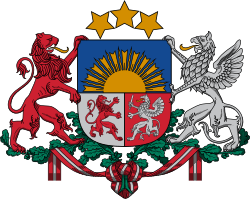| Government | Dates | Prime Minister | Coalition parties |
|---|
| 1st | Provisional | 18 November 1918 – 11 June 1920 | | Kārlis Ulmanis | LZS, LRDP, DS, LRP, LNP |
| 2nd | Ulmanis I | 20 June 1920 – 18 June 1921 | | Kārlis Ulmanis | LZS, DS, ENDP, DP, LgZP |
| 3rd | Meierovics I | 19 June 1921 – 18 July 1922 | | Zigfrīds Anna Meierovics | LZS, DP, LgZP, SDML, LTP |
| 4th | Meierovics II | 20 July 1922 – 26 January 1923 | | Zigfrīds Anna Meierovics | LZS, DP, LgZP, SDML |
| 5th | Pauļuks | 27 January 1923 – 27 June 1923 | | Jānis Pauļuks | DC, LZS, LKZS, JS, LSDSP, SDML |
| 6th | Meierovics III | 28 June 1923 – 26 January 1924 | | Zigfrīds Anna Meierovics | LZS, DC, LgZP, LSDSP, LKZS, SDML |
| 7th | Zāmuēls | 25 January 1924 – 17 December 1924 | | Voldemārs Zāmuēls | BPNC, DC, LKZS, JS |
| 8th | Celmiņš | 19 December 1924 – 23 December 1925 | | Hugo Celmiņš | LZS, DC, JS, SDML |
| 9th | Ulmanis II | 24 December 1925 – 6 May 1926 | | Kārlis Ulmanis | LZS, LKZS, LgZP, LJSP, JS, NA |
| 10th | Alberings | 7 May 1926 – 18 December 1926 | | Arturs Alberings | LZS, DC, LJSP, JS, LgZP |
| 11th | Skujenieks I | 19 December 1926 – 23 January 1928 | | Marģers Skujenieks | SDML, LSDSP, DC, PTA, JS |
| 12th | Juraševskis | 24 January 1928 – 30 November 1928 | | Pēteris Juraševskis | DC, KZKP, LgZP, LZS, DbRP |
| 13th | Celmiņš II | 1 December 1928 – 26 March 1931 | | Hugo Celmiņš | LZS, DC, KA, KZKP, LDZA, LJSP, NA, DbRP |
| 14th | Ulmanis III | 27 March 1931 – 5 December 1931 | | Kārlis Ulmanis | LZS, KZKP, LZPA, LJSP, MKRA, NA |
| 15th | Skujenieks II | 6 December 1931 – 23 March 1933 | | Marģers Skujenieks | PA, LZS, DC, LZPA, LJSP |
| 16th | Bļodnieks | 24 March 1933 – 16 March 1934 | | Ādolfs Bļodnieks | LJSP, KZKP, PA, LZS, DC, LZPA, KA |
| 17th | Ulmanis IV | 17 March 1934 – 15 May 1934 | | Kārlis Ulmanis | LZS, KDB, KZKP, LZPA |
| 18th | Ulmanis V | 16 May 1934 – 19 June 1940 | | Kārlis Ulmanis | Authoritarian régime |
| 19th | Kirhenšteins | 20 June 1940 – 25 August 1940 | | Augusts Kirhenšteins | Soviet occupation |
| Alternating Soviet and Nazi régimes. See Latvian Diplomatic Service in exile. |
| 20th | Godmanis I | 7 May 1990 – 3 August 1993 | | Ivars Godmanis | LTF, LC |
| 21st | Birkavs | 3 August 1993 – 19 September 1994 | | Valdis Birkavs | LC, LZS, LZP |
| 22nd | Gailis | 19 September 1994 – 21 December 1995 | | Māris Gailis | LC, TPA, LZS, LZP, TB |
| 23rd | Šķēle I | 21 December 1995 – 13 February 1997 | | Andris Šķēle | DPS, TB, LC, LNNK, LZS, LZP, LVP |
| 24th | Šķēle II | 13 February 1997 – 7 August 1997 | | Andris Šķēle | DPS, TB, LC, LNNK, LZS, LZP, KDS |
| 25th | Krasts | 7 August 1997 – 26 November 1998 | | Guntars Krasts | TB/LNNK, LC, LZS, LZP, DPS, KTP |
| 26th | Krištopans | 26 November 1998 – 16 July 1999 | | Vilis Krištopans | LC, TB, JP, LSDSP |
| 27th | Šķēle III | 16 July 1999 – 5 May 2000 | | Andris Šķēle | TP, LC, TB/LNNK |
| 28th | Bērziņš | 5 May 2000 – 7 November 2002 | | Andris Bērziņš | LC, TP, TB/LNNK, JP |
| 29th | Repše | 7 November 2002 – 9 March 2004 | | Einars Repše | JL, ZZS, TB/LNNK, LPP |
| 30th | Emsis | 9 March 2004 – 2 December 2004 | | Indulis Emsis | ZZS, TP, LPP |
| 31st | Kalvītis I | 2 December 2004 – 7 November 2006 | | Aigars Kalvītis | TP, ZZS, LPP, JL |
| 32nd | Kalvītis II | 7 November 2006 – 20 December 2007 | | Aigars Kalvītis | TP, ZZS, LPP/LC, TB/LNNK |
| 33rd | Godmanis II | 20 December 2007 – 12 March 2009 | | Ivars Godmanis | LPP/LC, TP, ZZS, TB/LNNK |
| 34th | Dombrovskis I | 12 March 2009 – 3 November 2010 | | Valdis Dombrovskis | JL, TP, ZZS, TB/LNNK, PS |
| 35th | Dombrovskis II | 3 November 2010 – 25 October 2011 | | Valdis Dombrovskis | Unity, ZZS |
| 36th | Dombrovskis III | 25 October 2011 – 22 January 2014 | | Valdis Dombrovskis | Unity, RP, NA |
| 37th | Straujuma I | 22 January 2014 – 5 November 2014 | | Laimdota Straujuma | Unity, RP, NA, ZZS |
| 38th | Straujuma II | 5 November 2014 – 11 February 2016 | | Laimdota Straujuma | Unity, NA, ZZS |
| 39th | Kučinskis | 11 February 2016 – 23 January 2019 | | Māris Kučinskis | Unity, NA, ZZS |
| 40th | Kariņš I | 23 January 2019 – 14 December 2022 | | Krišjānis Kariņš | K, AP!, NA, KPV LV (2019–2021), JV |
| 41st | Kariņš II | 14 December 2022 – 15 September 2023 | | Krišjānis Kariņš | JV, AS, NA |
| 42nd | Siliņa | 15 September 2023 – Present | | Evika Siliņa | JV, ZZS, PRO |





